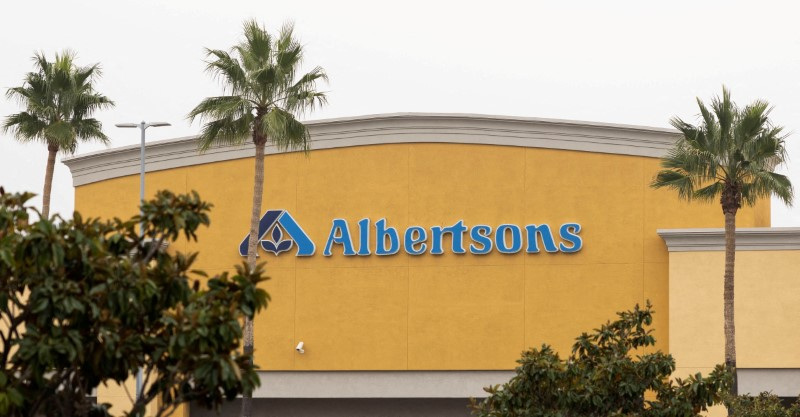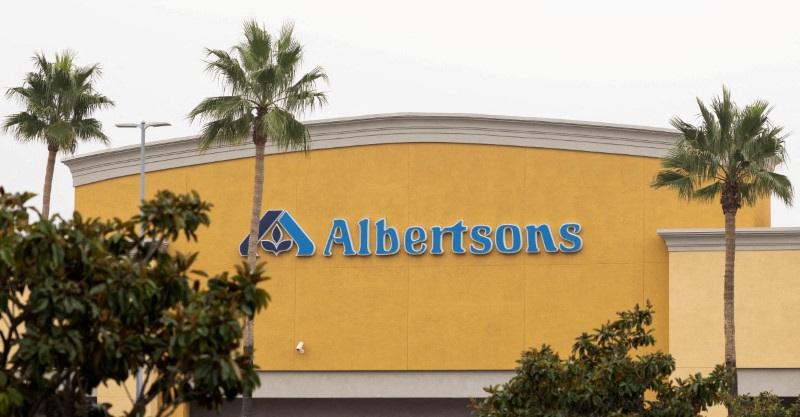
By Siddharth Cavale
NEW YORK (Reuters) -Kroger and Albertsons (NYSE:ACI) could turn to fast-growing and profitable advertising ventures to tackle competition and grow after a failed $25 billion merger between the two supermarket rivals, analysts said.
Retailers like Amazon (NASDAQ:AMZN), Target (NYSE:TGT), Walmart (NYSE:WMT), and grocers like Tesco (OTC:TSCDY) have created in-store and online media platforms that generate advertising revenue from big food companies and consumer product makers.
“While this deal was blocked on the grounds of reduced competition, competitive intensity still remains a big factor for the grocery industry given scale of retailers like Walmart, Costco (NASDAQ:COST), Amazon, BJ’s Wholesale and Target,” Jefferies analyst Rob Dickerson said.
Albertsons terminated its merger with Kroger (NYSE:KR) after courts blocked the deal and also sued the grocer, alleging a breach of contract that led to the deal’s demise.
With rising food prices, shoppers have turned to grocers like Kroger, Albertsons and Walmart, finding it more economical to cook at home. This increased foot traffic has allowed the retailers to collect valuable first-party customer data.
By leveraging it, Kroger and Albertsons could attract major advertisers like Procter & Gamble (NYSE:PG), Unilever (LON:ULVR), and Kraft Heinz (NASDAQ:KHC), who value the ability to place targeted ads, analysts have said.
“Kroger also is growing beyond food… New growth areas—especially personal finance and advertising/media —are significantly more profitable than core food retail and should boost the profit profile,” Telsey Advisory analyst Joseph Feldman said.
Retail media networks are highly profitable, with profit margins ranging between 40%-70%, compared to the typical 3-4% from selling everyday items.
Additionally, the market for retail media is expected to capture $82 billion in spending by 2027, growing at an annual rate of 17%, according to analysts at TD Cowen.
“By investing in and expanding retail media networks, all regional players can… create new revenue opportunities and remain competitive without relying solely on scale,” said Alastair James, chief commercial & marketing Officer for Swiftly, which helps build retail media networks for regional chains.
Kroger expects its retail media network, Kroger Precision Marketing, to grow by 20% in 2024. Executives reaffirmed this growth forecast in their recent earnings call on Dec. 5.
Kroger, which does not break out sales for the network, raked in about $150 billion in annual revenue, while Albertsons recorded nearly $80 billion.
Albertsons, which stopped providing guidance since the merger announcement in 2022, had said in July that year it continued to invest in its fledgling retail media arm, the Albertsons Media Collective.
Market leader Amazon accounted for 74.2% of U.S. retail media ad spending, according to an eMarketer survey in October 2023. Walmart, which generated about $3 billion in 2023 from Connect, its retail media arm, accounted for 7.5%.
To be sure, the business accounted for a small portion of Walmart’s total revenue of roughly $650 billion.
“(Retail media) is still a fast-growing part of our business, and the outcomes that we’re seeing continue to demonstrate that we’re well positioned for that growth,” Todd Foley, Kroger’s interim chief financial officer, said last week.
“As we look at those CPGs (consumer packaged goods companies) that are advertising with us, we see the outsized return on ad spend that they’re generating. And that’s why…we’re seeing those results.”

